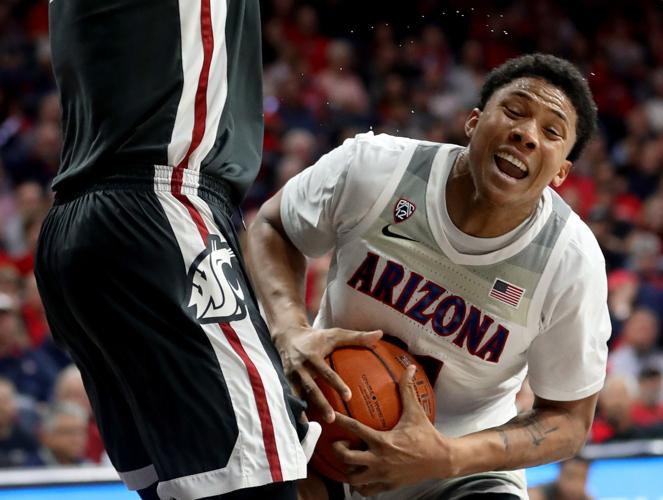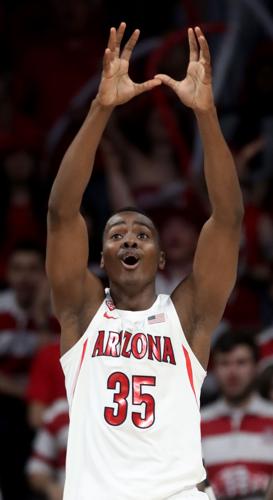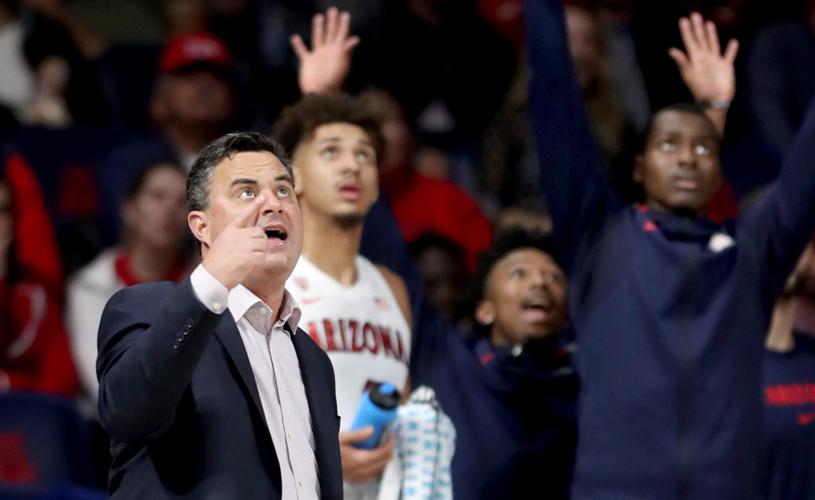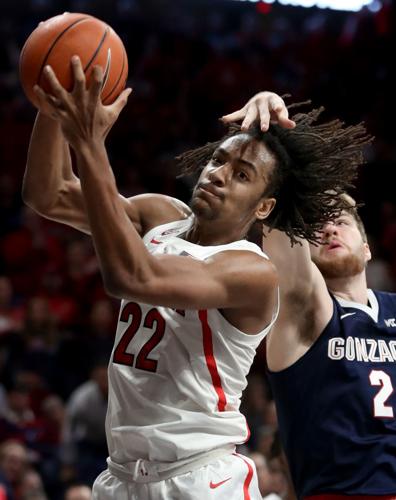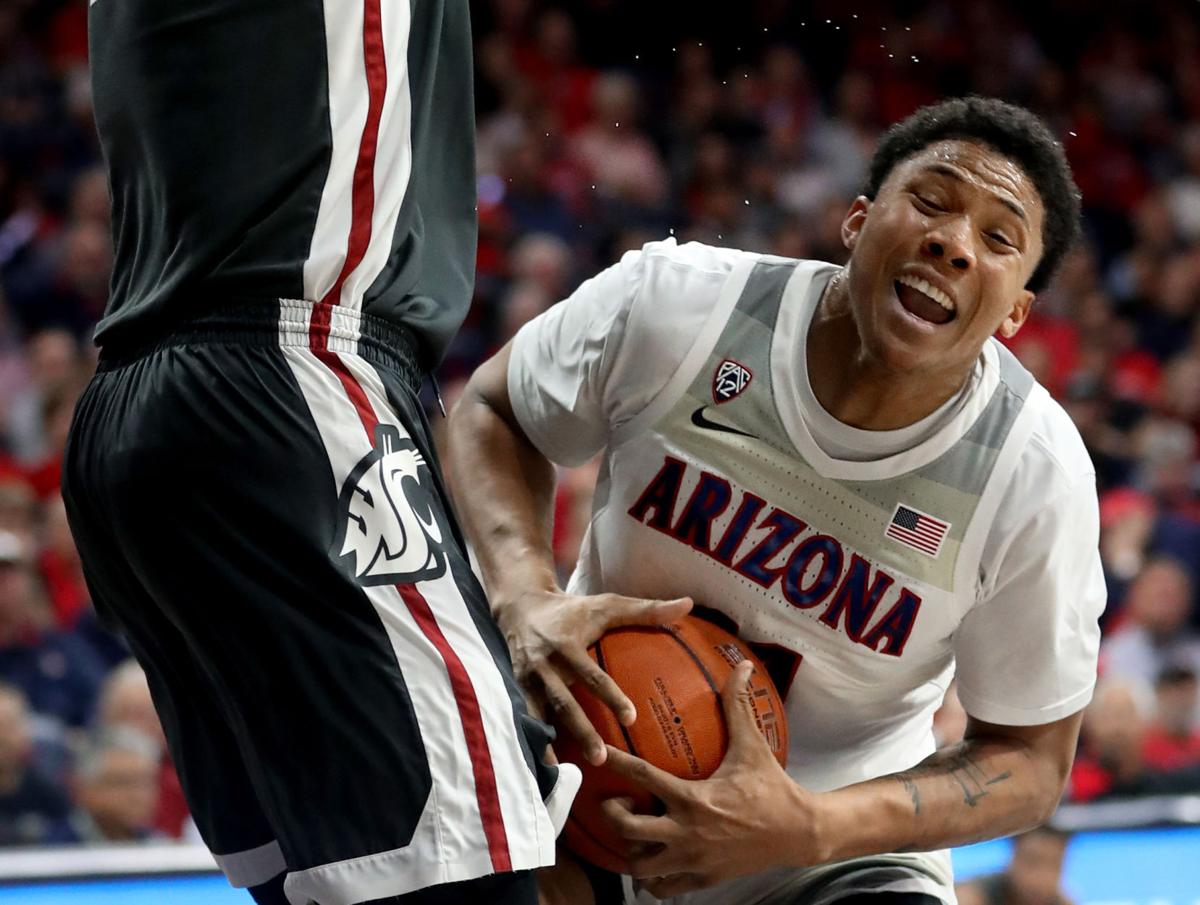In times like these, maybe a little gallows-type humor is the best way to put the Arizona Wildcats’ season to bed.
Maybe the only way.
“At least we won our last game of the year,” said Ryan Reynolds, UA’s director of basketball operations. “I’ve never said that before.”
That they did. Just hours before virtually the entire sports world came to a halt last week, Arizona beat Washington 77-70 on Wednesday in a Pac-12 Tournament game at Las Vegas, showing a balanced offensive attack, careful late-game ballhandling and a defense that held the Huskies to just 3-for-23 3-point shooting.
It was the kind of performance that folks might have expected out of the 2019-20 Wildcats a lot more often.

Christian Koloko was a pleasant surprise during his freshman season, playing in all of Arizona’s Pac-12 Conference games.
They had, after all, brought in a loaded freshman class that included five-star recruits in Nico Mannion and Josh Green plus a four-star forward in Zeke Nnaji who turned out to be better than anyone anticipated and a “project” in center Christian Koloko who swatted shots and electrified McKale Center fans immediately as a slender 7-foot freshman.
The Wildcats also had an infusion of grad transfers Max Hazzard (UC Irvine) and Stone Gettings (Cornell) to join returnees Chase Jeter, Ira Lee and Dylan Smith, while conventional transfer Jemarl Baker won a waiver request to play right away after transferring from Kentucky.
At least for a while, sophomore fan favorite Devonaire Doutrive was along for the ride, too.
It was a barbell of a roster — powered mostly by four fifth-year seniors and four true freshmen — that suggested chemistry challenges and learning curves ahead.
Mannion and Green were known for playing their best in the open court, yet the Wildcats occasionally traded speed for efficiency in early games. That was too much for UA coach Sean Miller, who chided them for throwing up what he called quick “circus” shots.
At the same time, as Nnaji emerged as one of the nation’s most efficient offensive players over the first month of the season, the mantra became “Feed Zeke” whenever possible.
“Clearly, being able to get him the ball in scoring position is a big, big deal, a really, really big deal,” Miller said late last month. “Maybe the biggest deal that we have going on here at Arizona basketball in ’19-20.”

UA coach Sean Miller and the Wildcats bench watch a video replay in a November game against South Dakota State in McKale Center. The UA started the season hot, but was inconsistent during the heart of Pac-12 play.
But, except for a few flashes like Wednesday’s game, a 21-point home win over Washington State on March 5 and their mid-February sweep in the Bay Area, the Wildcats’ learning curve was largely flat, with a few bumps both up and down along the way.
Relative to other teams, Arizona might have even plateaued or regressed, depending on your point of view.
Arizona lost four of its last six games, falling out of the AP Top 25 for good on Feb. 24, and below the top-four seed lines in NCAA Tournament projections. The Wildcats were likely to receive between a No. 7 or No. 9 seed in the NCAA Tournament — maybe a notch higher if they managed to beat Oregon in the Pac-12 Tournament semifinals or won the entire event.
In short, it was a season that peaked early; one that was known more for close losses than statement wins.
A season of almosts.
Here’s one look at how it played out:
The ascension (and a dismissal): Nov. 10-Nov. 24
The Wildcats held six straight home games to start the season, and ran away with five of them.
But in their fifth game, a 71-64 win over South Dakota State on Nov. 21, tensions within the UA offense first surfaced.
Nnaji shot 84.6% over his first four games, immediately emerging as the Wildcats’ most reliable scoring source, yet didn’t take a single shot in the first half against the Jackrabbits — who took a 32-29 lead.

Arizona guard Nico Mannion, center, splits between Pepperdine forward Kessler Edwards, left, and guard Skylar Chavez, right, to shoot during the second half of an NCAA college basketball game at the Wooden Legacy tournament in Anaheim, Calif.
Instead, UA players took 14 3-point shots in the first half – and hit only three of them.
“You have the nation’s leading field goal shooter on your team and he doesn’t take one jump hook? Not one? That’s a problem,” Miller said after the game. “And we had 13 3-point shots at the half. We had 10 twos. We were eight for 10 from two. And we had 12 turnovers, plus 13 threes.
“That’s as poor and inefficient, ineffective, not playing to win, not playing smart, 20 minutes as we’ve had in a long, long time, especially considering the way that our team is constructed.”
Miller also said that players who weren’t shooting well would either “shoot less, or play less” and vowed that it would “be corrected first thing tomorrow.”
At 1:23 p.m. the next day, Arizona issued a statement saying Doutrive had been dismissed. Doutrive had already been suspended for UA’s Nov. 1 exhibition game and the first two games of the regular season for unspecified reasons. He was 1 for 6 from the field against South Dakota State.
A trophy (and troubling injuries): Nov. 28-Dec. 1
Another upside to the Wildcats’ truncated season: They were one of the few teams that actually was able to win a tournament championship, at the Wooden Legacy tournament in Anaheim, California.
Although the Thanksgiving weekend games were watched in person only by low-four-figure crowds at Anaheim Arena, the Wildcats provided some of their top highlights of the season.
In the first game, Mannion hit a tricky jump-hook-floater game-winner from the right of the basket as he drove out of bounds to give Arizona a 93-91 win over Pepperdine.
The next night, Mannion put on his most masterful offensive performance of the season, hitting shots from all levels, and with all different styles, to lead the Wildcats to a 92-82 win over Penn.
Then, with Nnaji in foul trouble in the championship game against Wake Forest, Smith poured in 4 of 6 3-pointers and Jeter had 17 points and nine rebounds in a 73-66 Arizona win. Mannion was named MVP, while Jeter and Smith joined him on the all-conference team.
“If Dylan Smith and Chase Jeter didn’t play the way they played tonight, I don’t know if we would have left here as champions,” Miller said.
As Arizona basked in that moment, two health issues popped up against Penn.
Mannion suffered stiffness to his back, which led in part to his 3-for-11 shooting effort against Wake Forest and subsequent month-long shooting slump.
Gettings suffered a concussion, broken facial bone and black eye in a collision under the basket. His symptoms worsened over the weekend to the point where he didn’t even leave the team’s hotel for the Wake Forest game. Gettings did not attend practices for a week, missed UA’s trip to Baylor on Dec. 7, and did not return until start of Pac-12 play.
The near-misses (and DNPs): Dec. 7-Jan. 9
Arizona’s best “wins” in 2019-20 might have been losses: A five-point defeat at Baylor, a four-point loss at Gonzaga and a one-point overtime loss at Oregon.
Three games against what were top-10 teams at the time, two of them on the road. It’s the sort of things the computers love and, combining with UA’s average margin of victory of 20 points, is why Arizona finished with a No. 14 rating in the NET and No. 19 on Kenpom.com.
But it was a frustrating trend for the Wildcats. They finished the season just 3-7 in games decided by five points or less, unable to close out the biggest opportunities on their schedule.
Arizona finished the Baylor game by making just 2 of its final 19 field goals. The Wildcats went 0 for 6 with three turnovers during a critical second-half stretch when the Zags went on a game-changing 12-0 run.
At Oregon, the Wildcats gave it away several times. Mannion turned the ball over and Payton Pritchard blocked Nnaji’s shot in the final minute of regulation. In overtime, Mannion missed a floater and couldn’t get the ball to Green on an inbounds pass in the final seconds.
Frustration after frustration after frustration.

Arizona forward Zeke Nnaji (22) pulls down a rebound in front of Gonzaga forward Drew Timme (2) in the first half of their match-up between top 20 teams at McKale Center, Tucson, Ariz., December 14, 2019.
“Did we make a lot of great plays? No doubt,” Miller said after that Jan. 9 Oregon game in Eugene. “But those six, eight plays — rebounding, scrum for the ball, loose balls at the top of the key … it just seemed like they were better than us in those plays.”
The first Oregon game also marked the beginning of the end for Jeter, who went 0 for 3 with only one rebound in 12 minutes. He was benched with more than 13 minutes left in regulation.
While it was reminiscent of how Miller didn’t play either Smith or Lee in the second half on Dec. 21 against St. John’s in San Francisco, Jeter’s detention was of a more permanent sort.
Jeter played just 18 minutes three days later at Oregon State and was subsequently taken out of the starting lineup for an apparent combination of a sore back and lack of rebounding.
Miller also did not play Hazzard in the second half of UA’s 66-65 loss at ASU on Jan. 25.
“We’re only playing guys who are going to help us win the game, and if you’re not up to the task, we’re moving on to the next player,” Miller said after the Oregon game.
The decline (and some distractions): Jan. 12- Feb. 29
During the thick of Pac-12 play, the Wildcats had some of their highest and lowest moments.
They recovered from a dispiriting 17-point loss at Oregon State by sweeping Utah and Colorado easily at home.
Their 75-54 win over Colorado on Jan. 18, when four Wildcats scored 12 or more points and the Buffs managed just 36.7% shooting, arguably ranks as their best of the season.
After losing their first four road games of the season, the Wildcats also turned that problem around quickly: They became the first team in Pac-12 to sweep a two-game road trip, when Baker hit 4 of 7 3-pointers to help UA edge Washington 75-73 in Seattle and Gettings collected 19 points and 12 rebounds in a 66-49 win at Washington State.
“You need everybody to win in a great conference like we have,” Miller said in Pullman. “There are no easy games and winning on the road has never been more difficult.”
The Wildcats also swept the Bay Area trip in mid-February, but concerning games kept happening: a 22-point meltdown in the loss at Arizona State, and after the Washington trip, a near-meltdown at home against USC, when the Trojans cut what was a 20-point, second-half lead down to three in the final minute.
“I don’t know if I’ve felt better about this year’s team on that (Washington) trip, but tonight we obviously reverted,” Miller said after the USC game.
Two days later, the Wildcats shot just 25.4% from the field overall and missed all 12 3-pointers they took in the second half of a 65-52 loss to UCLA at McKale Center.
The Wildcats then trended slightly upward, with wins over Cal, Stanford and Oregon State before losing again to Oregon, this time at home. Green and Koloko each missed a pair of potential game-winning free throws, Green near the end of regulation and Koloko with 1.4 seconds left in overtime, allowing Oregon to hang on for a 73-72 win.
Miller placed the blame not on the late missed free throws but on several lost rebounding opportunities, including when Nnaji could not secure the ball as it fell following his block of Pritchard’s layup with 18 seconds left.
“Those are the plays that I think really drive you crazy because that’s just absolute toughness and effort,” Miller said. “I wish we were better in that area, we’re not. And that’s why we have the number of losses that we do.”
That loss turned into a three-game skid when the Wildcats went to Los Angeles to play USC and UCLA.
Hazzard sat out at USC for what the UA said were personal reasons, returned to face UCLA —and then sat out the rest of the season. Hazzard did not appear on the Wildcats’ bench in the Pac-12 Tournament, though a spokesman said he made the trip.
Jeter, meanwhile, was suspended for the UA’s final two regular-season games for unspecified reasons.
A last uptick (and what-ifs): March 5-March 11
The Wildcats sandwiched an embarrassing Senior Day loss to Washington with two of their more complete games of the season, beating Washington State 83-62 at home on March 5 and beating Washington 77-70 in the doomed Pac-12 Tournament.
More important for the rest of the Wildcats’ postseason, perhaps, was the fact that Green returned from missing the Los Angeles trip with a sore lower back by averaging 10 points against the Washington schools – and then putting up his best offensive performance since that Pepperdine game against Washington on Wednesday.
In what turned out to be Arizona’s final game of the season, Green was 5 for 10 overall and hit 3 of 4 3s, plus 6 of the 7 free throws he attempted.
“This might have been his overall best game of the year today,” Miller said afterward. “It’s great to see him play well in March, especially because we missed him. You can see how much we missed him.”
But, less than 24 hours later, the Wildcats found out they’ll never get to see how well Green might have played the rest of March.
They’ll never know how Jeter might have kept responding to his reinstatement in his final games, or whether Hazzard would have ever returned to hit a clutch 3 as he did while leading UC Irvine to its first-ever NCAA Tournament win a year ago. Or whether Gettings would capitalize on the postseason opportunity offered when he came over from Cornell.
They’ll never know if Mannion would have figured a way to get it done when it matters the most, with everything on the line in the NCAA Tournament.
On this Selection Sunday, there are no answers.
Only questions.


